February 24, 2017
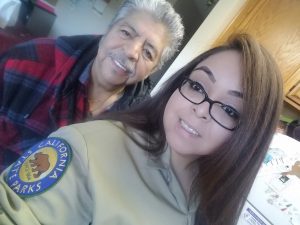 Yovania Paniagua recently started as an Interpretive Park Aide at the Castro Adobe. Yovania got connected with the Castro Adobe when she visited the park with her daughter’s school field trip.
Yovania Paniagua recently started as an Interpretive Park Aide at the Castro Adobe. Yovania got connected with the Castro Adobe when she visited the park with her daughter’s school field trip.
“I fell in love with the place,” Yovania said, whose dad (pictured with her on her first day) played a big role in her love of the woods, the environment and educating people.
She started volunteering at the park in June of 2016 and officially started as a Park Aide in February 2017. Working for California State Parks has always been a dream for her. Yovania said she loves talking to visitors about the history of the park, meeting new people who share her interests and being outdoors all day. She also is bilingual and helps with translation for visitors.
“I wanted to work at the Castro Adobe because I love the history behind it and it’s right in my back yard,” Yovania said.
Castro Adobe State Historic Park is at 184 Old Adobe Road in Watsonville. The park which is undergoing a multi-year restoration effort led by Friends of Santa Cruz State Parks, is currently only open for prescheduled tours, monthly open house events and special celebrations, such as Vaqueros on the Rancho on May 6.
January 6, 2017
Castro Adobe State Historic Park will host monthly open house events in 2017. Located at 184 Old Adobe Road, Watsonville, the two-story Rancho San Andrés Castro Adobe, built between 1848-49, is one of the finest examples of a rancho hacienda in the Monterey Bay area.
The Castro Adobe is open on a limited basis as Friends leads a multi-year restoration effort to preserve and interpret Pajaro Valley’s first State Historic Park in partnership with California State Parks.
- Saturday, Jan. 21, Beginnings at the Adobe: The Castro family has been at the leading edge of California history.
- Saturday, Feb. 11, Romance on the Rancho: The adobe has hosted its share of love and loss.
- Saturday, March 18, Luck o’ the Castros: Luck comes and goes. Good choices have preserved the Castro Adobe.
- Saturday, April 22, Vaqueros y Bandidos: Connect to when cattle ranching was king on the California coast.
- Saturday, May 13, Women of the Castro Adobe: Honor the women who helped preserve the Castro Adobe.
- Saturday, June 17, Papas of the Castro Adobe: The fathers of the Castro family etched their name into the CA landscape.
- Saturday, July 22, The Castro Adobe in the American Era: The Castro Adobe influenced the development of the Pájaro Valley.
- Saturday, Aug. 19, Evening at the Adobe: A state historic park, the Castro Adobe is a place for community celebrations.
- Saturday, Sept. 16, The Pájaro Valley in the Mexican Era: The ranching lifestyle shaped the society we live in today.
- Saturday, Oct. 14, Earthquakes and the Adobe: Adaptations have helped the building survive shaky ground.
- Saturday, Nov. 18, Thankful for Our Stewards: Our stewards have key roles in Castro Adobe’s history and future.
- Saturday, Dec. 9, Festivos en el Rancho: Celebrate the holidays season!
All events are 11 a.m. to 3 p.m. with the exception of Evenings at the Adobe on Aug. 19, which will be 6-9 p.m. Admission is free; donations are gratefully accepted. Parking is limited; please carpool.
December 16, 2016
By Charlie Kieffer, Castro family descendant and Castro Adobe Committee member
I want to share with you something very heartwarming that took place at the end of a school tour at the Castro Adobe on Friday, Dec. 2.
We had 19 kindergarten children from Watsonville Charter School for the Arts. They had a very good time. They did roping, tortilla making, adobe brick making and checked out the bear skin.
It is such a joy to see very young children take their minds to places that we adults will never understand … or maybe we just lost how to do it.
To make a small adobe brick and be so very proud to show it to you and then tell you that they are going to take it home to show their mother and father… To make a tortilla, cook it on a cooking area that has a very hot, flaming fire, put whatever they want on the tortilla — no one is telling them what to put on it — and think it’s the best tortilla they ever ate …
At the end of the tour, their teacher handed me an envelope and said, “What a great time they had.” On that envelope was all of the 19 children’s names and inside the envelope was $47.50 in cash. Each child had donated $2.50 for the Castro Adobe. It was so very heartwarming!
October 20, 2016
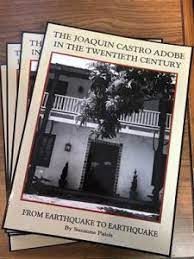 The long out-of-print title “The Joaquin Castro Adobe in the Twentieth Century: From Earthquake to Earthquake” by Suzanne Paizis will be available for purchase in the Friends of Santa Cruz State Parks pop-up ParkStore at Saturday’s Castro Adobe open house. Varvara Paizis, daughter of the author, provided the books. The books will be sold for $25. (The books are so hard to find, copies have been listed for hundreds of dollars on Amazon.com.)
The long out-of-print title “The Joaquin Castro Adobe in the Twentieth Century: From Earthquake to Earthquake” by Suzanne Paizis will be available for purchase in the Friends of Santa Cruz State Parks pop-up ParkStore at Saturday’s Castro Adobe open house. Varvara Paizis, daughter of the author, provided the books. The books will be sold for $25. (The books are so hard to find, copies have been listed for hundreds of dollars on Amazon.com.)
The open house, “Earthquakes and the Adobe,” will be 11 a.m. to 3 p.m. Saturday at Castro Adobe State Historic Park. Learn more.
The book also will be available in the ParkStore at Santa Cruz Mission State Historic Park.
September 28, 2016
A visit to the Castro Adobe in Watsonville immerses students in our community’s story from the heyday of the vaquero to the 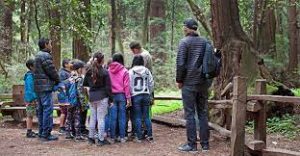 aftermath of the Loma Prieta earthquake. Hands-on, sensory experiences bring more than a century of history to life, while guided investigations of students’ own inquiries make learning personally relevant. You don’t need to leave the Pájaro Valley to touch a real adobe and connect with California’s colorful past.
aftermath of the Loma Prieta earthquake. Hands-on, sensory experiences bring more than a century of history to life, while guided investigations of students’ own inquiries make learning personally relevant. You don’t need to leave the Pájaro Valley to touch a real adobe and connect with California’s colorful past.
The free tours are 2.5 hours long and offer curriculum that supplements teaching of third grade (local history) and fourth grade (California history) content standards. Email Interpreter Joseph Carr Ritchie or call 831-226-9669 to schedule a visit.
Learn more about field trips to local State Parks and Beaches.
September 14, 2016
Grants totaling $1,054,800 were made to 54 nonprofits in our latest round of funding by Community Foundation Santa Cruz County, including a $20,000 gift to Friends of Santa Cruz State Parks for further restoration of the Castro Adobe, California’s newest State Historic Park.
The gifts were announced in late August. Read more about the grants.
May 17, 2016
After years of planning, design modifications, site preparation and funding procurement, the steel beam which will support the second floor was installed on Friday, May 13.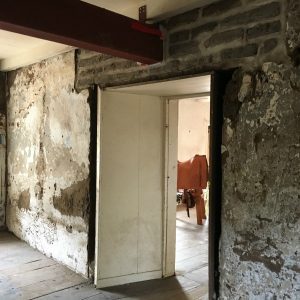
The beam was carefully brought into the building and inserted underneath the second floor joists by Sea Berg Metal Fabricators, Inc. The steel beam was cranked and lifted into the place, running the entire length of the adobe building.
Everyone on the site was ecstatic at the install of the beam and emotions ran high as the beam, so long in the planning, was finally installed. A long-term goal of the Castro Adobe renovations is to increase access for all. The beam strengthens the second floor of the historic structure, making it possible for a larger number of visitors to go upstairs.
This picture doesn’t do it justice. Come see the beam for yourself at the next Open House Day , 11 a.m. to 3 p.m., Saturday, June 11.
May 10, 2016
A custom replica 19th Century “Californio” saddle was unveiled at Castro Adobe State Historic Park during the April open house event.
San Juan Bautista State Historic Park docent John Grafton crafted the period-specific saddle especially for the Castro Adobe. He attended the open house to demonstrate the materials, tools and techniques he used, and visitors got to try their hand at leather-working with him.
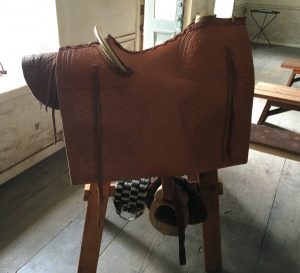 Much like the Castro family who built the adobe, John Grafton has made cattle a way of life. His childhood and early career took him to ranches throughout the West—of both North and South America. During and after a later career in law enforcement, John developed a relationship with California State Parks as a docent specializing in hands-on demonstrations of the horse culture of early California.
Much like the Castro family who built the adobe, John Grafton has made cattle a way of life. His childhood and early career took him to ranches throughout the West—of both North and South America. During and after a later career in law enforcement, John developed a relationship with California State Parks as a docent specializing in hands-on demonstrations of the horse culture of early California.
He currently volunteers at San Juan Bautista State Historic Park, where he does blacksmithing, leather and rawhide work, and woodworking — and combines these activities with interpretation of the material and social culture of the early Californios. Grafton said he started volunteering at Sutters Fort in Sacramento and, when the park’s administration learned he had a background in ranching, he was encouraged to create an interpretation of a Californio saddle.
“That has led me to research and attempt to make accurate representations of the early Californio saddle, and the Castro Adobe saddle is my latest effort in this ongoing project,” Grafton said.“May it serve to increase our understanding, appreciation and enjoyment of our Californio heritage. ”
The saddle was commissioned by an enthusiastic supporter of the park who said, “I’m very pleased to donate it to the Castro Adobe organization…. (I feel) it is important for visitors to have a visual sense of an early California saddle from the era of the Castro Adobe. Saddles have changed through the years to meet various needs, but aspects of our early California saddles remains the same.”
Basics of saddle:
- Tree – hand carved out of Douglas Fir wood.
- Stirrups – hand carved from local oak wood.
- Leather Coverings – all have an individual purpose. All imprinted by hand made tools with floral and geometric motifs known in the mid-1800s era.
Spring will bring two more opportunities for the public to visit the Castro Adobe and view the saddle — as well as the restored cocina (kitchen), Potter-Church garden and more. Join us for “A Founding Family of California,” the story of the Castros’ arrival in California as told from the perspective of Spanish explorer Juan Bautista de Anza, 11 a.m. to noon, Saturday, May 21. The next Castro open house event will focus on life at the adobe after the Castros. The park will open for “The Castro Adobe in the 20th Century” from 11 a.m. to 3 p.m., Saturday, June 11.
April 6, 2016
Friends wishes to thank Harold “Hal” Hyde of Corralitos for the generous donation of an antique solid mahogany Faro Table for our collection at the Kimbro House at the Castro Adobe State Historic Park.
“Faro was the most popular card game in the Old West… much more popular than poker because it was amazingly easy to play and odds for winning were the best of all gambling games,” according to the Sharlot Hall Museum. “Nary a saloon in the West was without it between 1825 and 1915…Because the game generally moved fast, it was very easy to cheat.”
The table donated by Mr. Hyde reportedly “came around the horn” in 1868 before completion of the transcontinental railroad. It was used from 1875-1925 at the Five Mile House Saloon at the northeast corner of Corralitos Road and Freedom Boulevard (then the Santa Cruz/Watsonville Highway). The Five Mile House served customers from all over the area and was possibly a stage stop. The saloon was about a mile from the Castro Adobe as the crow flies.
The table was purchased by Mr. Hyde’s parents, Harold A. Hyde, Sr. and Fern Kilburn Hyde, around 1925 after they saw it on a back platform at the saloon. After the elder Mr. Hyde’s untimely death in 1926, Mrs. Hyde used the table in her homes in Watsonville and Berkeley. It was then given to their son, Mr. Hyde, who used it at various locations — including for many years at his Corralitos home and as a conference table in his office at UCSC where he was the first Vice Chancellor of Business and Finance at the university.
In addition to helping to found UCSC, the younger Mr. Hyde helped establish Cabrillo College, the Community Foundation of Santa Cruz County, the Cultural Council and the UCSC Arboretum.
Friends is so honored by his gift of this family treasure. We also would like to thank his daughter, Marilyn Hyde, for helping to facilitate this wonderful donation to Friends. One interesting feature of the Faro table design is a special cut-out area where the dealer sat.
We look forward to telling the story of this fascinating table to the public and learning more about the history of this kind of entertainment in the area. Was Faro played at the infamous Fandango dances held at the Castro Adobe?
This blog post was written by Bonny Hawley, executive director, Friend of Santa Cruz State Parks.
January 28, 2016
The Castro Adobe State Historic Park will be open to the public six Saturdays in 2016. Admission is free with donations to support the park gratefully accepted. Located in Larkin Valley, near Watsonville, the two-story Castro Adobe, built between 1848-49, is one of the finest examples of a rancho hacienda in the Monterey Bay area.
Open House visitors will be able to tour the property including the restored cocina (kitchen) and the Potter-Church Garden. The garden is a unique outdoor space originally created by then-owners Elizabeth and David Potter (1968-72), in consultation with noted landscape architect Thomas Church.
Each open house will be themed to highlight an aspect of the historic property. The Open House Days begin Feb. 20 with “Romance on the Rancho.” Enjoy traditional hot chocolate, make tortillas, stroll through the historic garden and more.
Future dates include: April 23: Vaqueros y Banditos (Cowboys and Bandits), June 11: Castro Adobe in the 20th Century, Aug. 13: Evening at the Adobe, Oct. 15: Earthquakes and the Adobe, Dec. 3: Festivos en el Rancho (Holidays at the Rancho). The open houses will be 11 a.m. to 3 p.m., with the exception of the August evening event.
State Park Interpretive Rangers and Friends’ volunteers will be on hand to offer a “sneak peak” into the restoration process and to assist visitors who would like to enjoy handmade tortillas cooked on the recently reconstructed brasero (stove).
The Castro Adobe is located at 184 Old Adobe Road, north of Watsonville. Parking is extremely limited, so carpooling is encouraged.
 Yovania Paniagua recently started as an Interpretive Park Aide at the Castro Adobe. Yovania got connected with the Castro Adobe when she visited the park with her daughter’s school field trip.
Yovania Paniagua recently started as an Interpretive Park Aide at the Castro Adobe. Yovania got connected with the Castro Adobe when she visited the park with her daughter’s school field trip. The long out-of-print title “The Joaquin Castro Adobe in the Twentieth Century: From Earthquake to Earthquake” by Suzanne Paizis will be available for purchase in the
The long out-of-print title “The Joaquin Castro Adobe in the Twentieth Century: From Earthquake to Earthquake” by Suzanne Paizis will be available for purchase in the  aftermath of the Loma Prieta earthquake. Hands-on, sensory experiences bring more than a century of history to life, while guided investigations of students’ own inquiries make learning personally relevant. You don’t need to leave the Pájaro Valley to touch a real adobe and connect with California’s colorful past.
aftermath of the Loma Prieta earthquake. Hands-on, sensory experiences bring more than a century of history to life, while guided investigations of students’ own inquiries make learning personally relevant. You don’t need to leave the Pájaro Valley to touch a real adobe and connect with California’s colorful past.
 Much like the Castro family who built the adobe, John Grafton has made cattle a way of life. His childhood and early career took him to ranches throughout the West—of both North and South America. During and after a later career in law enforcement, John developed a relationship with California State Parks as a docent specializing in hands-on demonstrations of the horse culture of early California.
Much like the Castro family who built the adobe, John Grafton has made cattle a way of life. His childhood and early career took him to ranches throughout the West—of both North and South America. During and after a later career in law enforcement, John developed a relationship with California State Parks as a docent specializing in hands-on demonstrations of the horse culture of early California.